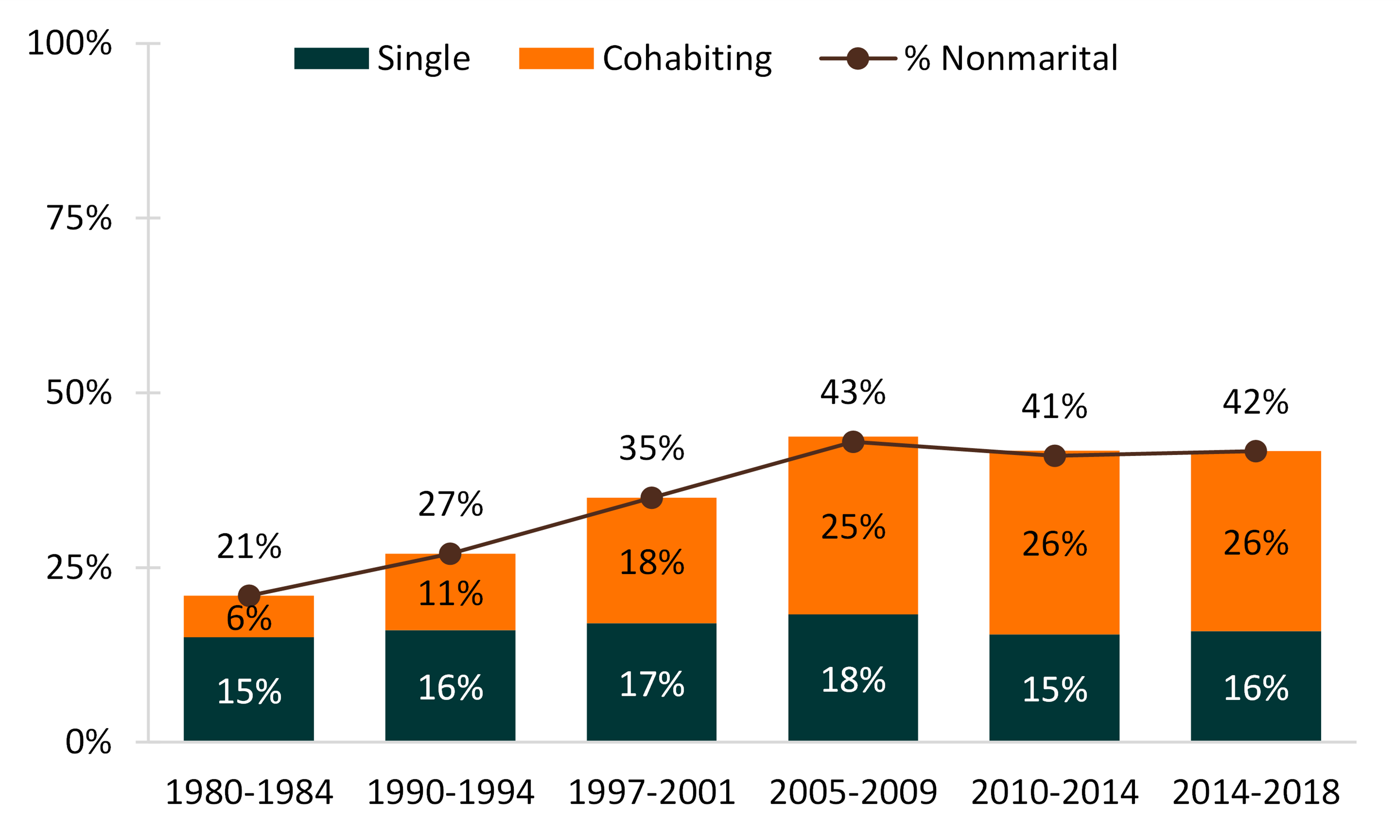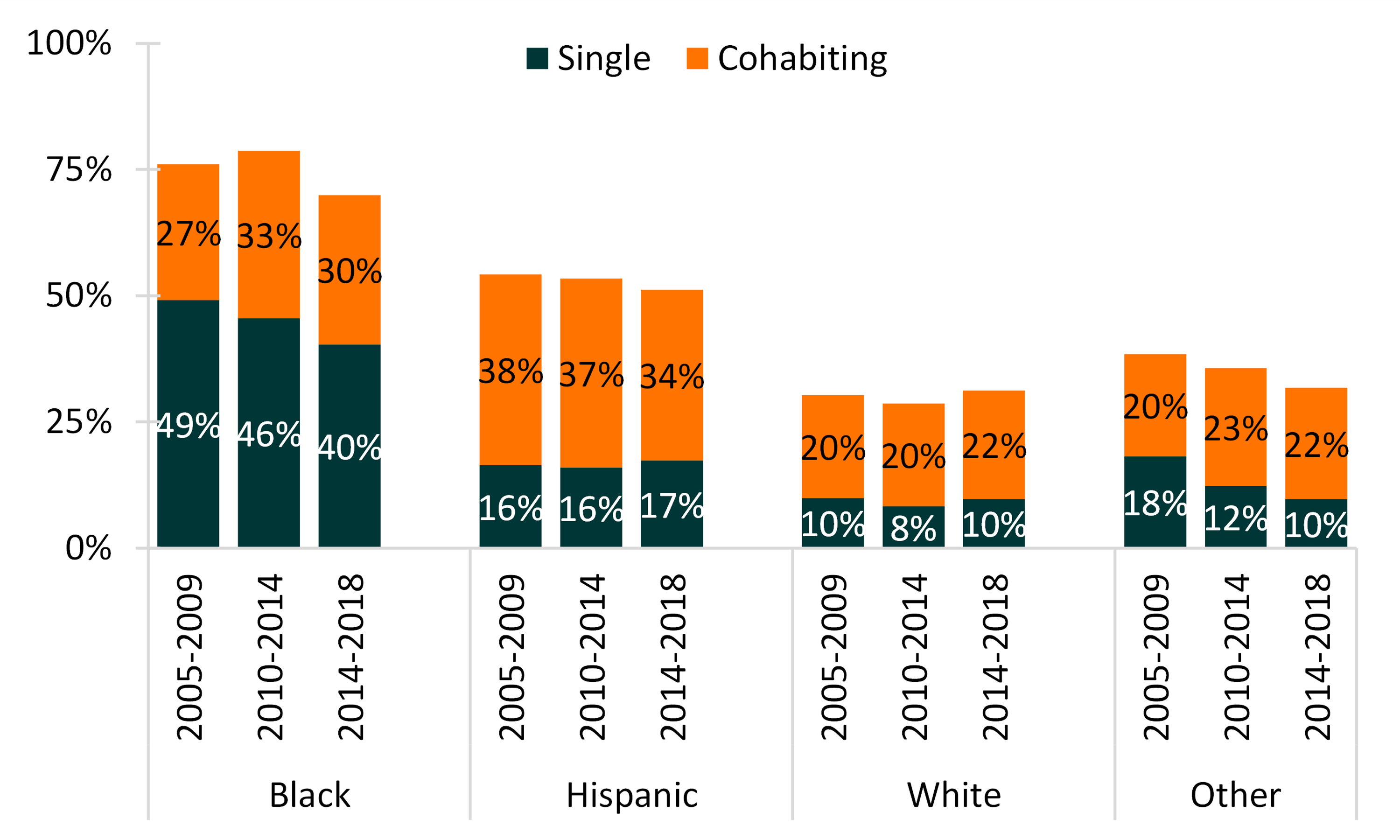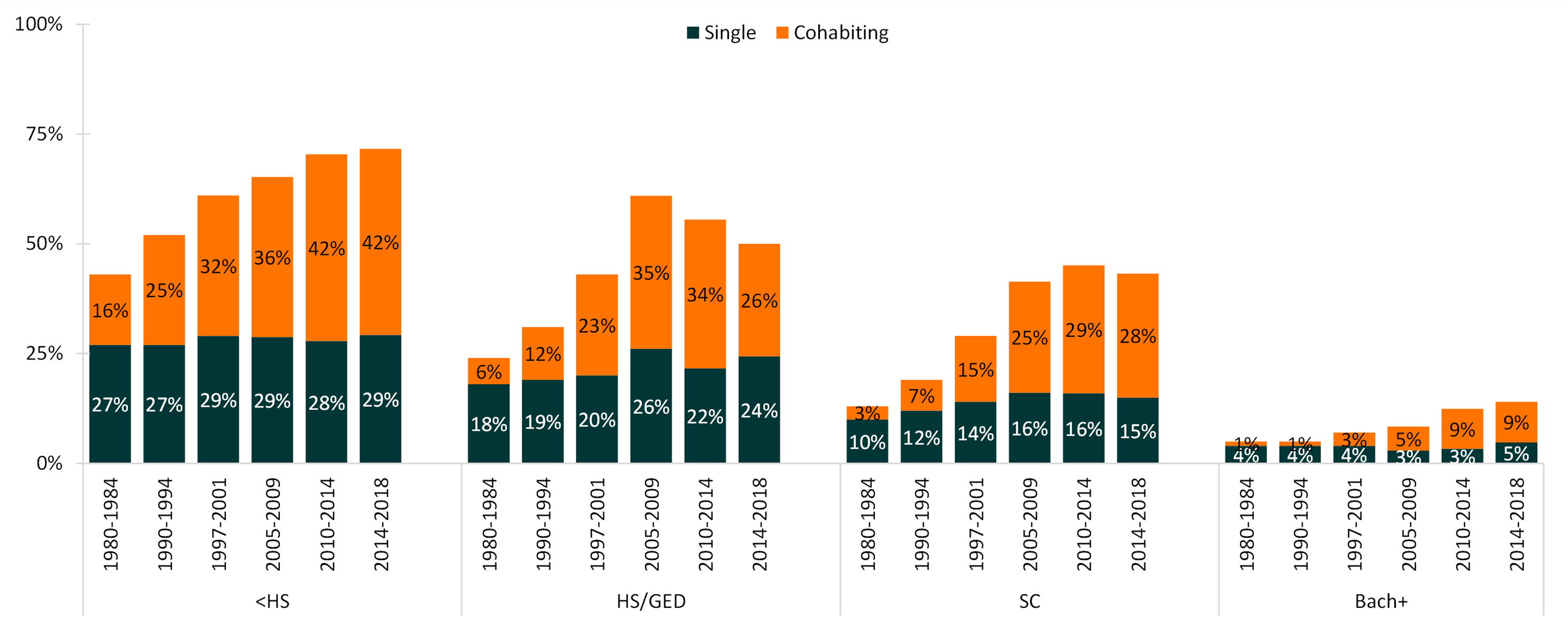Trends in Births to Single and Cohabiting Mothers Under 40, 1980-2018
Family Profile No. 17, 2021
Author: Karen B. Guzzo
After increases in the proportion of births occurring outside of marriage during the latter half of the 20th century into the early 2000s, the overall share has leveled off over the past decade, at roughly four in ten births (Martin et al., 2021). Much of the change in nonmarital childbearing was due to increases in births to cohabiting mothers (FP-15-03). Using data from several cycles of the National Survey of Family Growth (NSFG), this profile shows trends in the shares of births to single and cohabiting mothers under the age of 40 since the early 1980s, updating profiles FP-15-03 and FP-17-04.
Changes in the Shares of Births to Single and Cohabiting Mothers under Age 40
- Between 1980-84 and 2005-09, the share of all births occurring to unmarried mothers more than doubled from 21% to 43%. Since then, it has declined slightly but remained at just over four in ten births.
- The share of all births that were to single mothers (those who are not living with a cohabiting partner) changed little since the 1980s, fluctuating from 15-18% between 1980-84 and 2014-2018. Conversely, the share of all births to cohabiting women quadrupled – growing from 6% to 26%.
- In the early 1980s, seven in ten nonmarital births were to single mothers.
- In 2014-2018, less than four in ten nonmarital births were to single mothers
Figure 1. Changes in the Shares of Births to Single and Cohabiting Mothers Under Age 40 Among All Births

Changes in the Shares of Births to Single and Cohabiting Mothers under Age 40 by Race/Ethnicity
The shares of all births to unmarried women varied across race/ethnic groups, with the highest levels among Black mothers and the lowest among White mothers 1.The shares of all births to unmarried women varied across race/ethnic groups, with the highest levels among Black mothers and the lowest among White mothers. 1
- Among Black mothers, the share of all births to unmarried mothers rose from 76% in 2005-2009 to 79% in 2010-2014 before declining to 70% in 2014-2018.
- Both Hispanic and “Other” race mothers exhibited a decline in the share of births that were nonmarital.
- The share of all births that were nonmarital fell slightly from 2005-2009 to 2010-2014 for White mothers (from 30% to 28%) before rising to 32% in 2014-2018.
- For Hispanic, White, and “Other” race mothers, the majority of nonmarital births were to cohabitors; for Black mothers, the majority of nonmarital births were to single mothers.
Figure 2. Changes in the Shares of Births to Single and Cohabiting Mothers Under Age 40 Among All Births by Race/Ethnicity

Changes in the Shares of Births to Single and Cohabiting Mothers under Age 40 by Educational Attainment
All educational groups experienced an increase in the percentage of all births that occurred outside of marriage between the early 1980s and 2005-2009. After 2010, trends diverged across educational groups.
- Among mothers with no high school degree, the share of all births that were nonmarital rose from four in ten births in 1980-84 to more than seven in ten births in 2014-2018; births to single mothers stayed between 27-29% of all births.
- The share of all births that were nonmarital fell in recent years for both mothers with a high school diploma/GED and those with some college, with a much steeper decline for the former group. The share of births to cohabitors peaked in 2005-2009 for mothers with a high school diploma/GED (at 35%) and in 2010-2015 for mothers with some college (29%).
- Nonmarital births made up a very small share of all births to mothers with a Bachelor’s degree or more across the time period, though the percentage has nearly tripled from 5% in the early 1980s to 14% in 2014-2018.
Figure 3. Changes in the Shares of Births to Single and Cohabiting Mothers Under Age 40 Among All Births by Educational Attainment

References
Bumpass, L., & Lu, H. H. (2000). Trends in cohabitation and implications for children’s family contexts in the United States. Population Studies, 54(1), 29-41. http://dx.doi.org/10.1080/713779060
Kennedy, S., & Bumpass, L. (2008). Cohabitation and children’s living arrangements: New estimates from the United States. Demographic Research, 19(47), 1663–1692. http://dx.doi.org/10.4054/DemRes.2008.19.47
Manning, W. D., Brown, S. L., & Stykes, B. (2015). Trends in births to single and cohabiting mothers, 1980-2013. Family Profiles, FP-15-03. Bowling Green, OH: National Center for Family & Marriage Research. https://www.bgsu.edu/content/dam/BGSU/college-of-arts-and-sciences/NCFMR/documents/FP/FP-15-03-birth-trends-single-cohabiting-moms.pdf
Martin, J.A., Hamilton, B. E., Osterman, M. J. K, and Driscoll, A. K. (2021). Births: Final Data for 2019. Volume 70, Number 2 Hyattsville, MD: National Center for Health Statistics. https://www.cdc.gov/nchs/data/nvsr/nvsr70/nvsr70-02-508.pdf
Wu, H. (2017). Trends in births to single and cohabiting mothers, 1980-2014. Family Profiles, FP-17-03. Bowling Green, OH: National Center for Family & Marriage Research. https://www.bgsu.edu/ncfmr/resources/data/family-profiles/wu-trends-births-single-cohabiting-mothers-fp-17-04.html
Suggested Citation:
Guzzo, K. B. (2021). Trends in births to single and cohabiting mothers under 40, 1980-2018. Family Profiles, FP-21-17. Bowling Green, OH: National Center for Family & Marriage Research. https://doi.org/10.25035/ncfmr/fp-21-17
Updated: 11/07/2025 03:59PM


